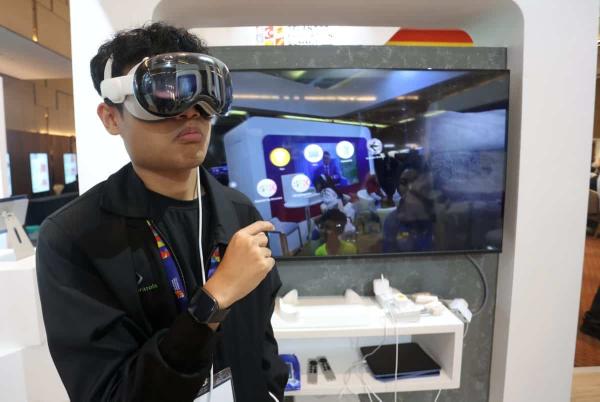By Danial Dzulkifly
SHAH ALAM, Feb 10 — Selangor’s ambitious goal to earn RM5 billion in annual revenue is within reach if the state government can embrace unconventional strategies beyond land and water resource management, said an economist.
Prof Emeritus Dr Barjoyai Bardai of the Malaysia University of Science and Technology proposed a bold framework for meeting the target — integrating digital innovation with sustainable development.
He said Selangor must achieve an average annual revenue growth of 15 per cent over the next five years, focusing on three key contributors: economic growth (RM1.5 billion), non-tax revenues (RM800 million), and improved tax compliance (RM700 million).
[caption id="attachment_256308" align="alignleft" width="276"] Economist Prof Emeritus Dr Barjoyai Bardai.[/caption]
Economist Prof Emeritus Dr Barjoyai Bardai.[/caption]
However, Barjoyai said conventional revenue-generating methods remain crucial, particularly in attracting targeted foreign direct investment and establishing special economic zones with streamlined regulations.
He also highlighted the importance of modernising tax administration through artificial intelligence, optimising the performance of state-owned enterprises, and developing public-private partnerships (PPPs) to drive infrastructure projects.
“By implementing these strategies systematically and maintaining strong political will, Selangor can realistically double its revenue within the desired timeframe.
“The state government can increase its revenue to RM5 billion in five years by focusing on economic growth, diversifying revenue streams, improving tax efficiency, leveraging PPPs, promoting sustainability, strengthening governance, and benchmarking best practices,” he said in a written response to Media Selangor.
Selangor’s financial trajectory has been promising, with the state recording RM2.858 billion in revenue in 2024, surpassing its previous peak of RM2.811 billion in 2017.
In recent years, revenue collection stood at RM2.7 billion in 2023, RM2.5 billion in 2022, and RM2.3 billion in 2021.
On January 30, Menteri Besar Dato’ Seri Amirudin Shari expressed confidence in the state’s ability to achieve RM5 billion in revenue by 2029, citing efficient resource management and the commitment of its civil servants as key factors in Selangor’s success.
[caption id="attachment_388103" align="aligncenter" width="1200"] Menteri Besar Dato' Seri Amirudin Shari delivers his New Year 2025 message at the Jubli Perak Auditorium of the State Secretariat Building, Shah Alam, on January 27, 2025. — Picture by NUR ADIBAH AHMAD IZAM/MEDIASELANGOR[/caption]
Menteri Besar Dato' Seri Amirudin Shari delivers his New Year 2025 message at the Jubli Perak Auditorium of the State Secretariat Building, Shah Alam, on January 27, 2025. — Picture by NUR ADIBAH AHMAD IZAM/MEDIASELANGOR[/caption]
Virtual towns, NFT, blockchain?
At the core of Barjoyai’s proposal is an unconventional strategy — the development of virtual cities and digital twins of towns across Selangor. These ecosystems would utilise technologies such as metaverse platforms, blockchain, artificial intelligence, and augmented reality.
“With careful planning, collaboration, and marketing, virtual cities can become a lucrative source of income while positioning Selangor as a leader in digital innovation,” he said, highlighting the potential revenue streams from virtual real estate leasing, NFT-based assets, gaming integrations, and data analytics services.
The plan also envisions businesses and entrepreneurs leasing virtual storefronts and office spaces within digital replicas of key Selangor townships, while blockchain-based smart contracts would ensure transparent and secure transactions.
Barjoyai projected that with moderate adoption rates within the first two years, pilot projects and initial leases could bring in RM100 million, while from the third to fifth year, scaled operations and recurring subscriptions could generate over RM500 million annually.
[caption id="attachment_374174" align="alignright" width="300"] Figurines with computers and smartphones seen in front of the words ‘Artificial Intelligence AI’ in this illustration taken on February 19, 2024. — Picture by REUTERS[/caption]
Figurines with computers and smartphones seen in front of the words ‘Artificial Intelligence AI’ in this illustration taken on February 19, 2024. — Picture by REUTERS[/caption]
Sustainable development to boost state coffers
Beyond digital initiatives, Barjoyai’s strategy also stressed alignment with sustainable development goals (SDGs), proposing green projects that could generate billions in long-term revenue.
“The Selangor government can achieve RM5 billion in revenue within five years by implementing SDG-aligned initiatives such as solar farm leasing, circular economy hubs, zero-waste markets, carbon offset marketplaces, and marine conservation tourism.
“These strategies not only generate significant revenue but also promote sustainability, inclusivity, and resilience, ensuring long-term benefits for the state and its people,” he said.
Some of Barjoyai’s suggestions are as follows:
- Lease state land for large-scale solar farms to provide a steady revenue stream while contributing to Malaysia’s renewable energy goals.
- Develop smart industrial parks with integrated Internet of Things systems to enhance efficiency and attract high-value investors.
- Establish circular economy hubs focused on waste processing and recycling to not only generate revenue, but support environmental sustainability.
- Set up zero-waste and carbon offset markets to attract eco-conscious businesses and individuals willing to invest in sustainable solutions.
- Promote marine conservation tourism and agroforestry projects to diversify Selangor’s economy. By leveraging its natural assets, the state could create new sources of income while protecting the environment.
On January 27, Amirudin said the state is on track to achieve a RM500 billion economy within the next three to five years, driven by advancements in complex industries such as semiconductors and ventures into artificial intelligence.
However, he cautioned state administrators and elected representatives to remain vigilant and avoid being complacent to achieve this goal, despite the state contributing over RM400 billion to the national economy last year.




